Mini Review on Cancer Progression, RAS Oncogene and Targeted Medicine
VerifiedAdded on 2022/10/11
|12
|2691
|6
Report
AI Summary
This mini-review explores the critical role of the RAS oncogene in brain cancer progression and potential therapeutic strategies. The assignment begins with an overview of brain cancer prevalence and the contributions of Australian scientists to understanding the disease, including the involvement of Kp enzymes and their impact on tumor progression. It then delves into the literature review, highlighting studies on interferon-gamma activation, vascular targeting, and the effects of various treatments like stereotactic radiosurgery and valproic acid combinations. The review further examines the RAS signaling pathway, discussing the function of Ras proteins, GTPases, and the role of GEFs and GAPs. The final section focuses on targeted medicine, including BIM and tyrosine kinase inhibitors (TKIs), and strategies to target the RAS oncogene directly and indirectly. The review emphasizes the importance of understanding the molecular pathways and the potential of targeted therapies in combating brain cancer.
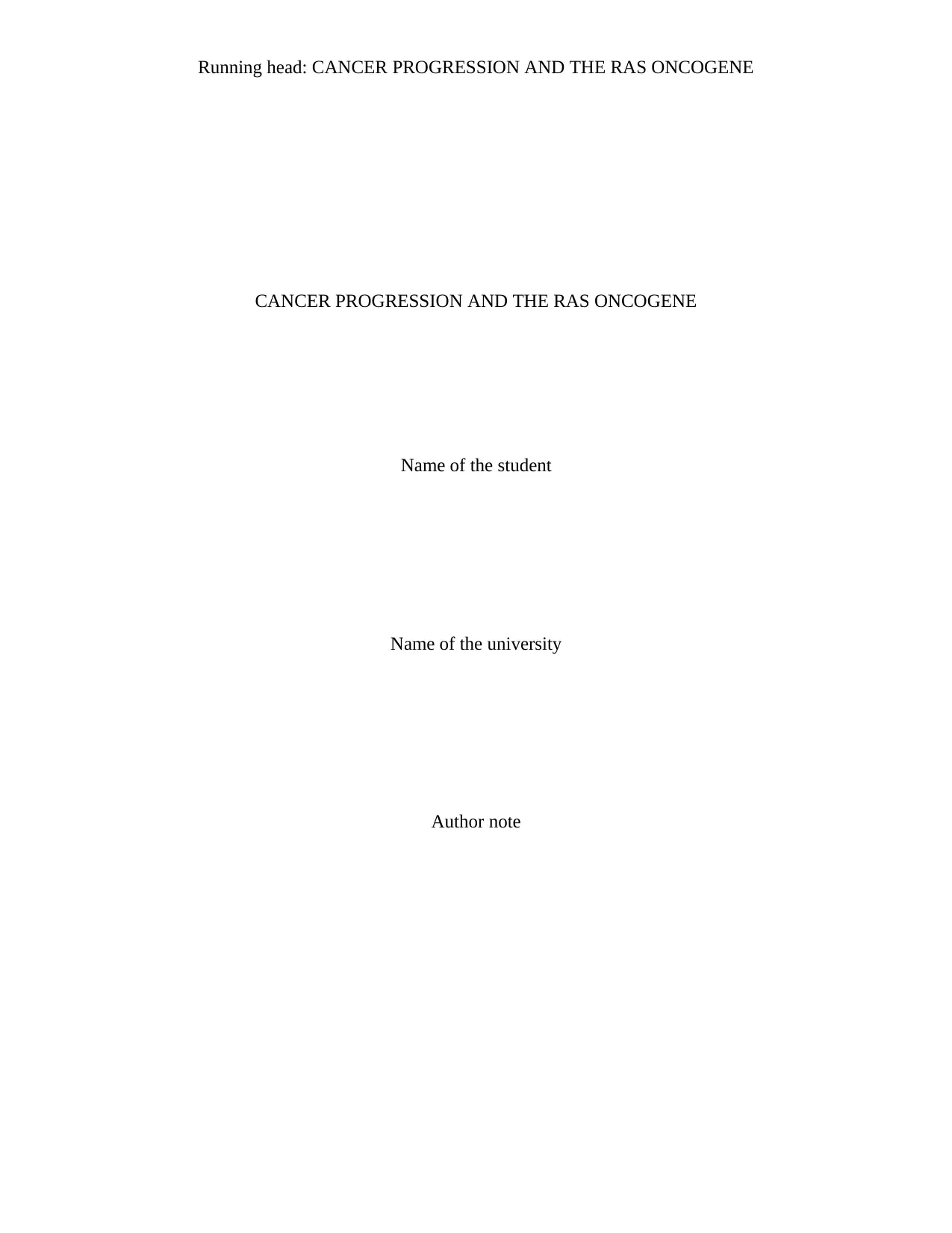
Running head: CANCER PROGRESSION AND THE RAS ONCOGENE
CANCER PROGRESSION AND THE RAS ONCOGENE
Name of the student
Name of the university
Author note
CANCER PROGRESSION AND THE RAS ONCOGENE
Name of the student
Name of the university
Author note
Paraphrase This Document
Need a fresh take? Get an instant paraphrase of this document with our AI Paraphraser
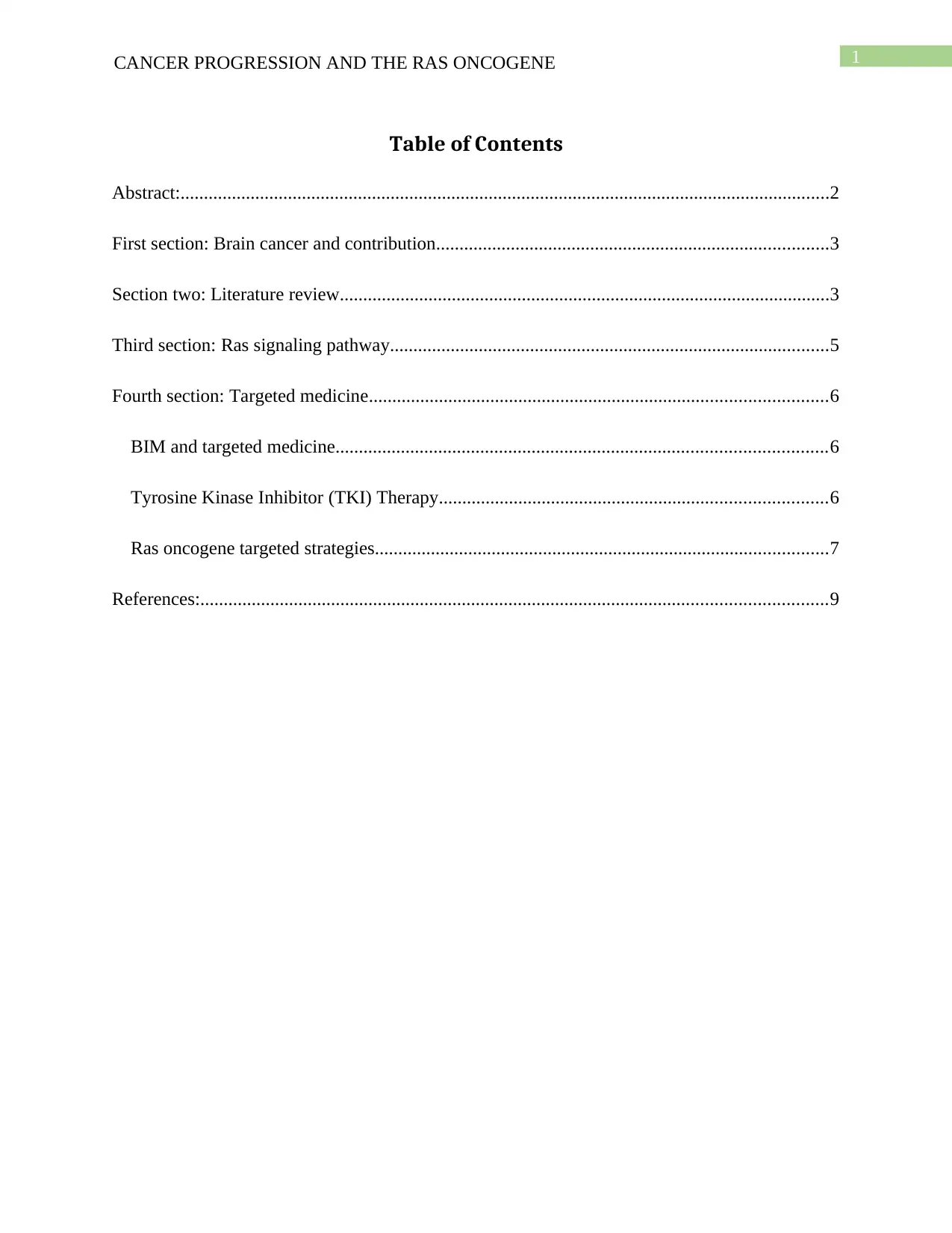
1CANCER PROGRESSION AND THE RAS ONCOGENE
Table of Contents
Abstract:...........................................................................................................................................2
First section: Brain cancer and contribution....................................................................................3
Section two: Literature review.........................................................................................................3
Third section: Ras signaling pathway..............................................................................................5
Fourth section: Targeted medicine..................................................................................................6
BIM and targeted medicine.........................................................................................................6
Tyrosine Kinase Inhibitor (TKI) Therapy...................................................................................6
Ras oncogene targeted strategies.................................................................................................7
References:......................................................................................................................................9
Table of Contents
Abstract:...........................................................................................................................................2
First section: Brain cancer and contribution....................................................................................3
Section two: Literature review.........................................................................................................3
Third section: Ras signaling pathway..............................................................................................5
Fourth section: Targeted medicine..................................................................................................6
BIM and targeted medicine.........................................................................................................6
Tyrosine Kinase Inhibitor (TKI) Therapy...................................................................................6
Ras oncogene targeted strategies.................................................................................................7
References:......................................................................................................................................9
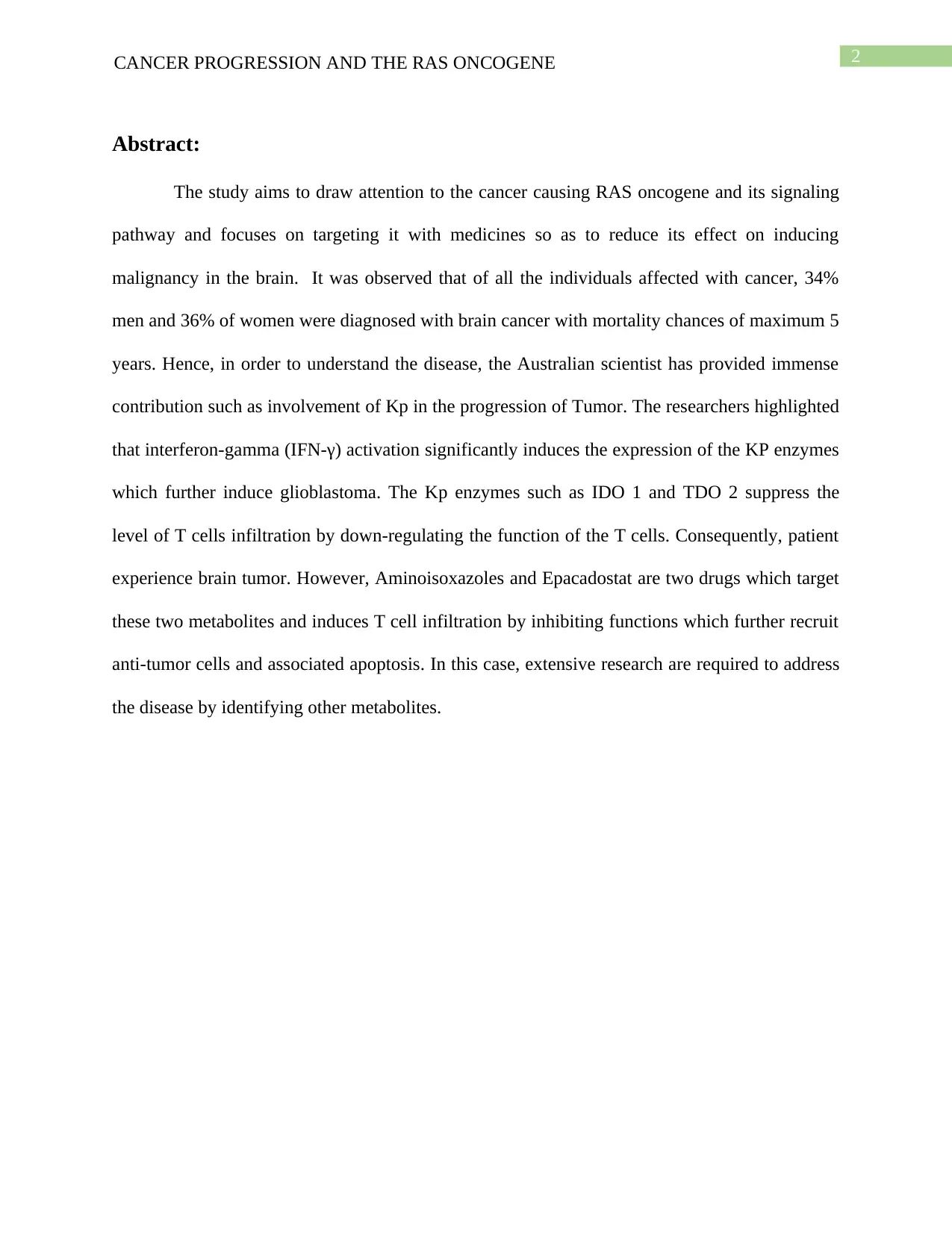
2CANCER PROGRESSION AND THE RAS ONCOGENE
Abstract:
The study aims to draw attention to the cancer causing RAS oncogene and its signaling
pathway and focuses on targeting it with medicines so as to reduce its effect on inducing
malignancy in the brain. It was observed that of all the individuals affected with cancer, 34%
men and 36% of women were diagnosed with brain cancer with mortality chances of maximum 5
years. Hence, in order to understand the disease, the Australian scientist has provided immense
contribution such as involvement of Kp in the progression of Tumor. The researchers highlighted
that interferon-gamma (IFN-γ) activation significantly induces the expression of the KP enzymes
which further induce glioblastoma. The Kp enzymes such as IDO 1 and TDO 2 suppress the
level of T cells infiltration by down-regulating the function of the T cells. Consequently, patient
experience brain tumor. However, Aminoisoxazoles and Epacadostat are two drugs which target
these two metabolites and induces T cell infiltration by inhibiting functions which further recruit
anti-tumor cells and associated apoptosis. In this case, extensive research are required to address
the disease by identifying other metabolites.
Abstract:
The study aims to draw attention to the cancer causing RAS oncogene and its signaling
pathway and focuses on targeting it with medicines so as to reduce its effect on inducing
malignancy in the brain. It was observed that of all the individuals affected with cancer, 34%
men and 36% of women were diagnosed with brain cancer with mortality chances of maximum 5
years. Hence, in order to understand the disease, the Australian scientist has provided immense
contribution such as involvement of Kp in the progression of Tumor. The researchers highlighted
that interferon-gamma (IFN-γ) activation significantly induces the expression of the KP enzymes
which further induce glioblastoma. The Kp enzymes such as IDO 1 and TDO 2 suppress the
level of T cells infiltration by down-regulating the function of the T cells. Consequently, patient
experience brain tumor. However, Aminoisoxazoles and Epacadostat are two drugs which target
these two metabolites and induces T cell infiltration by inhibiting functions which further recruit
anti-tumor cells and associated apoptosis. In this case, extensive research are required to address
the disease by identifying other metabolites.
⊘ This is a preview!⊘
Do you want full access?
Subscribe today to unlock all pages.

Trusted by 1+ million students worldwide
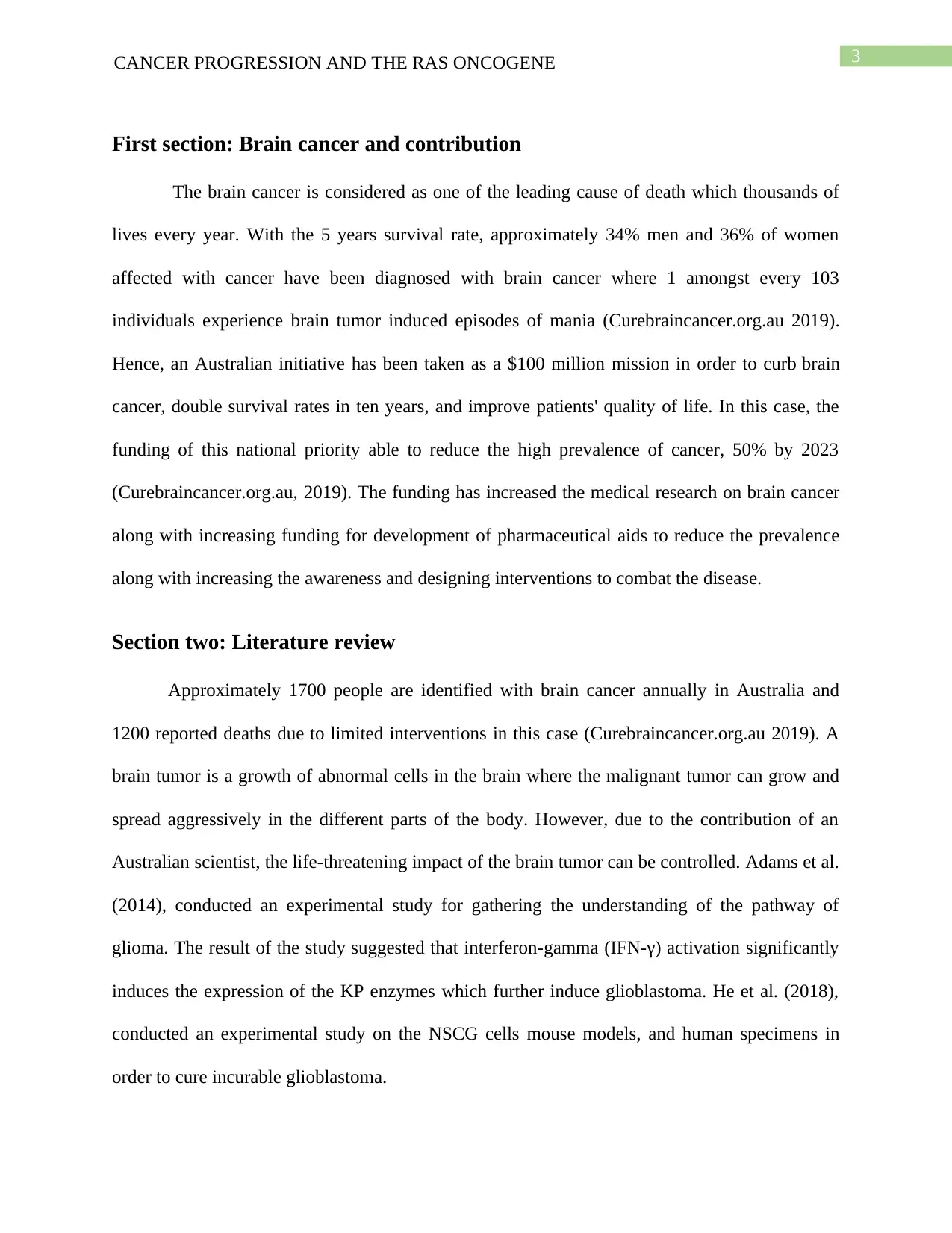
3CANCER PROGRESSION AND THE RAS ONCOGENE
First section: Brain cancer and contribution
The brain cancer is considered as one of the leading cause of death which thousands of
lives every year. With the 5 years survival rate, approximately 34% men and 36% of women
affected with cancer have been diagnosed with brain cancer where 1 amongst every 103
individuals experience brain tumor induced episodes of mania (Curebraincancer.org.au 2019).
Hence, an Australian initiative has been taken as a $100 million mission in order to curb brain
cancer, double survival rates in ten years, and improve patients' quality of life. In this case, the
funding of this national priority able to reduce the high prevalence of cancer, 50% by 2023
(Curebraincancer.org.au, 2019). The funding has increased the medical research on brain cancer
along with increasing funding for development of pharmaceutical aids to reduce the prevalence
along with increasing the awareness and designing interventions to combat the disease.
Section two: Literature review
Approximately 1700 people are identified with brain cancer annually in Australia and
1200 reported deaths due to limited interventions in this case (Curebraincancer.org.au 2019). A
brain tumor is a growth of abnormal cells in the brain where the malignant tumor can grow and
spread aggressively in the different parts of the body. However, due to the contribution of an
Australian scientist, the life-threatening impact of the brain tumor can be controlled. Adams et al.
(2014), conducted an experimental study for gathering the understanding of the pathway of
glioma. The result of the study suggested that interferon-gamma (IFN-γ) activation significantly
induces the expression of the KP enzymes which further induce glioblastoma. He et al. (2018),
conducted an experimental study on the NSCG cells mouse models, and human specimens in
order to cure incurable glioblastoma.
First section: Brain cancer and contribution
The brain cancer is considered as one of the leading cause of death which thousands of
lives every year. With the 5 years survival rate, approximately 34% men and 36% of women
affected with cancer have been diagnosed with brain cancer where 1 amongst every 103
individuals experience brain tumor induced episodes of mania (Curebraincancer.org.au 2019).
Hence, an Australian initiative has been taken as a $100 million mission in order to curb brain
cancer, double survival rates in ten years, and improve patients' quality of life. In this case, the
funding of this national priority able to reduce the high prevalence of cancer, 50% by 2023
(Curebraincancer.org.au, 2019). The funding has increased the medical research on brain cancer
along with increasing funding for development of pharmaceutical aids to reduce the prevalence
along with increasing the awareness and designing interventions to combat the disease.
Section two: Literature review
Approximately 1700 people are identified with brain cancer annually in Australia and
1200 reported deaths due to limited interventions in this case (Curebraincancer.org.au 2019). A
brain tumor is a growth of abnormal cells in the brain where the malignant tumor can grow and
spread aggressively in the different parts of the body. However, due to the contribution of an
Australian scientist, the life-threatening impact of the brain tumor can be controlled. Adams et al.
(2014), conducted an experimental study for gathering the understanding of the pathway of
glioma. The result of the study suggested that interferon-gamma (IFN-γ) activation significantly
induces the expression of the KP enzymes which further induce glioblastoma. He et al. (2018),
conducted an experimental study on the NSCG cells mouse models, and human specimens in
order to cure incurable glioblastoma.
Paraphrase This Document
Need a fresh take? Get an instant paraphrase of this document with our AI Paraphraser
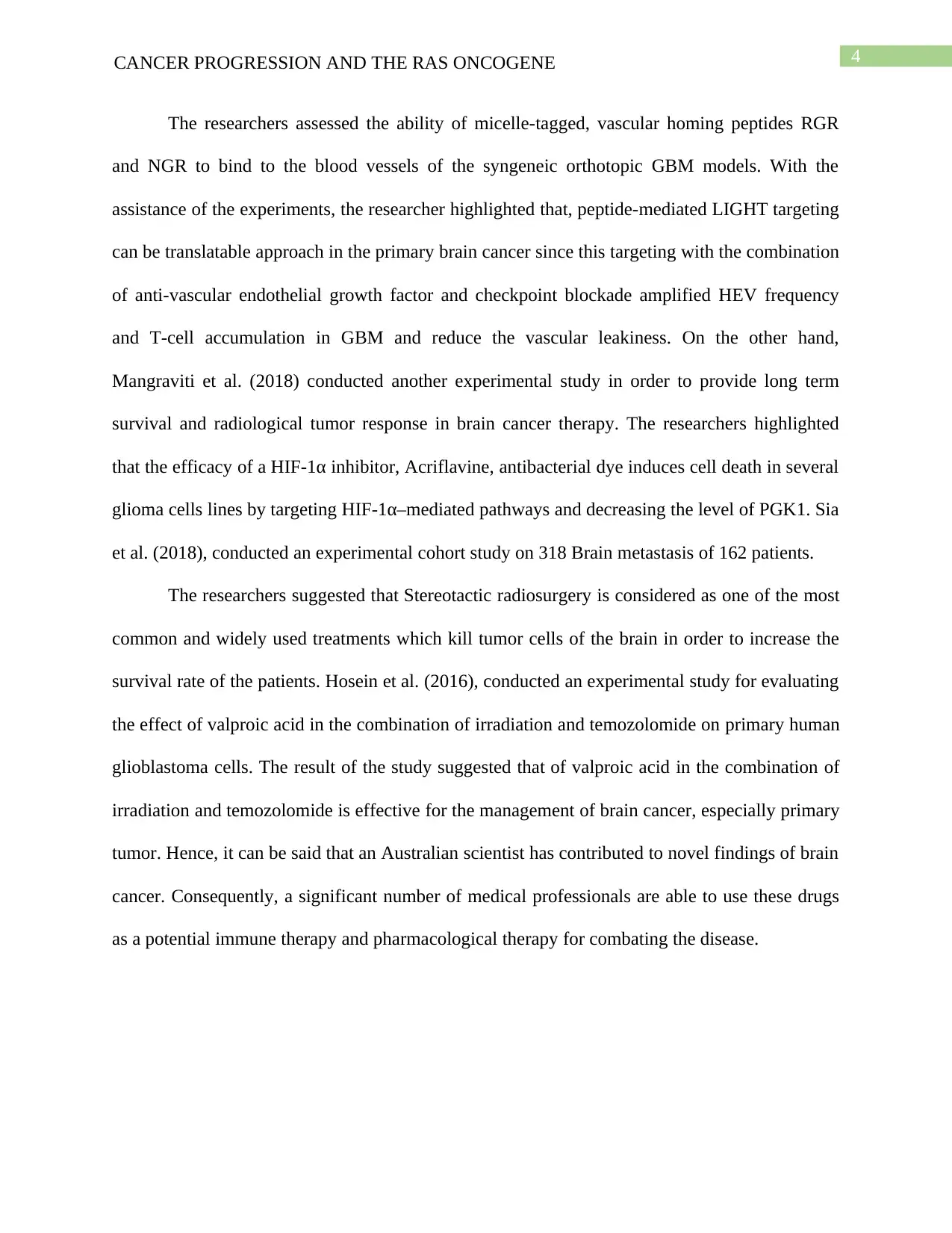
4CANCER PROGRESSION AND THE RAS ONCOGENE
The researchers assessed the ability of micelle-tagged, vascular homing peptides RGR
and NGR to bind to the blood vessels of the syngeneic orthotopic GBM models. With the
assistance of the experiments, the researcher highlighted that, peptide-mediated LIGHT targeting
can be translatable approach in the primary brain cancer since this targeting with the combination
of anti-vascular endothelial growth factor and checkpoint blockade amplified HEV frequency
and T-cell accumulation in GBM and reduce the vascular leakiness. On the other hand,
Mangraviti et al. (2018) conducted another experimental study in order to provide long term
survival and radiological tumor response in brain cancer therapy. The researchers highlighted
that the efficacy of a HIF-1α inhibitor, Acriflavine, antibacterial dye induces cell death in several
glioma cells lines by targeting HIF-1α–mediated pathways and decreasing the level of PGK1. Sia
et al. (2018), conducted an experimental cohort study on 318 Brain metastasis of 162 patients.
The researchers suggested that Stereotactic radiosurgery is considered as one of the most
common and widely used treatments which kill tumor cells of the brain in order to increase the
survival rate of the patients. Hosein et al. (2016), conducted an experimental study for evaluating
the effect of valproic acid in the combination of irradiation and temozolomide on primary human
glioblastoma cells. The result of the study suggested that of valproic acid in the combination of
irradiation and temozolomide is effective for the management of brain cancer, especially primary
tumor. Hence, it can be said that an Australian scientist has contributed to novel findings of brain
cancer. Consequently, a significant number of medical professionals are able to use these drugs
as a potential immune therapy and pharmacological therapy for combating the disease.
The researchers assessed the ability of micelle-tagged, vascular homing peptides RGR
and NGR to bind to the blood vessels of the syngeneic orthotopic GBM models. With the
assistance of the experiments, the researcher highlighted that, peptide-mediated LIGHT targeting
can be translatable approach in the primary brain cancer since this targeting with the combination
of anti-vascular endothelial growth factor and checkpoint blockade amplified HEV frequency
and T-cell accumulation in GBM and reduce the vascular leakiness. On the other hand,
Mangraviti et al. (2018) conducted another experimental study in order to provide long term
survival and radiological tumor response in brain cancer therapy. The researchers highlighted
that the efficacy of a HIF-1α inhibitor, Acriflavine, antibacterial dye induces cell death in several
glioma cells lines by targeting HIF-1α–mediated pathways and decreasing the level of PGK1. Sia
et al. (2018), conducted an experimental cohort study on 318 Brain metastasis of 162 patients.
The researchers suggested that Stereotactic radiosurgery is considered as one of the most
common and widely used treatments which kill tumor cells of the brain in order to increase the
survival rate of the patients. Hosein et al. (2016), conducted an experimental study for evaluating
the effect of valproic acid in the combination of irradiation and temozolomide on primary human
glioblastoma cells. The result of the study suggested that of valproic acid in the combination of
irradiation and temozolomide is effective for the management of brain cancer, especially primary
tumor. Hence, it can be said that an Australian scientist has contributed to novel findings of brain
cancer. Consequently, a significant number of medical professionals are able to use these drugs
as a potential immune therapy and pharmacological therapy for combating the disease.

5CANCER PROGRESSION AND THE RAS ONCOGENE
Third section: Ras signaling pathway
When the RAS oncogene is mutated, the cells grow nonstop by evading the death
signals. The RAS mutation makes the cells resistant towards a few available therapies to combat
the cancer also. The normal RAS generally receives the signals and follows the signals to quickly
switch among the active form of GTP and inactive GDP form (West et al. 2015). Ras proteins
are the GTPases which function as the molecular switches for the signaling pathways that
regulate the proliferation of cells, the survival along with growth and differentiation along with
cytoskeletal dynamism. The Ras proteins transduce the signals from the extracellular growth
factor by regular cycling between the inactive GDP state and active GTP states (Sarkisian and
Davar 2018). This exchange of GTP with GDP on the RAS is stringently regulated by the
guanine nucleotide exchange factors or the GEFs along with the GTPase-activating proteins or
the GAPs. The activated RAS or the RAS-GTP regulates the multiple functions of the cells via
Third section: Ras signaling pathway
When the RAS oncogene is mutated, the cells grow nonstop by evading the death
signals. The RAS mutation makes the cells resistant towards a few available therapies to combat
the cancer also. The normal RAS generally receives the signals and follows the signals to quickly
switch among the active form of GTP and inactive GDP form (West et al. 2015). Ras proteins
are the GTPases which function as the molecular switches for the signaling pathways that
regulate the proliferation of cells, the survival along with growth and differentiation along with
cytoskeletal dynamism. The Ras proteins transduce the signals from the extracellular growth
factor by regular cycling between the inactive GDP state and active GTP states (Sarkisian and
Davar 2018). This exchange of GTP with GDP on the RAS is stringently regulated by the
guanine nucleotide exchange factors or the GEFs along with the GTPase-activating proteins or
the GAPs. The activated RAS or the RAS-GTP regulates the multiple functions of the cells via
⊘ This is a preview!⊘
Do you want full access?
Subscribe today to unlock all pages.

Trusted by 1+ million students worldwide
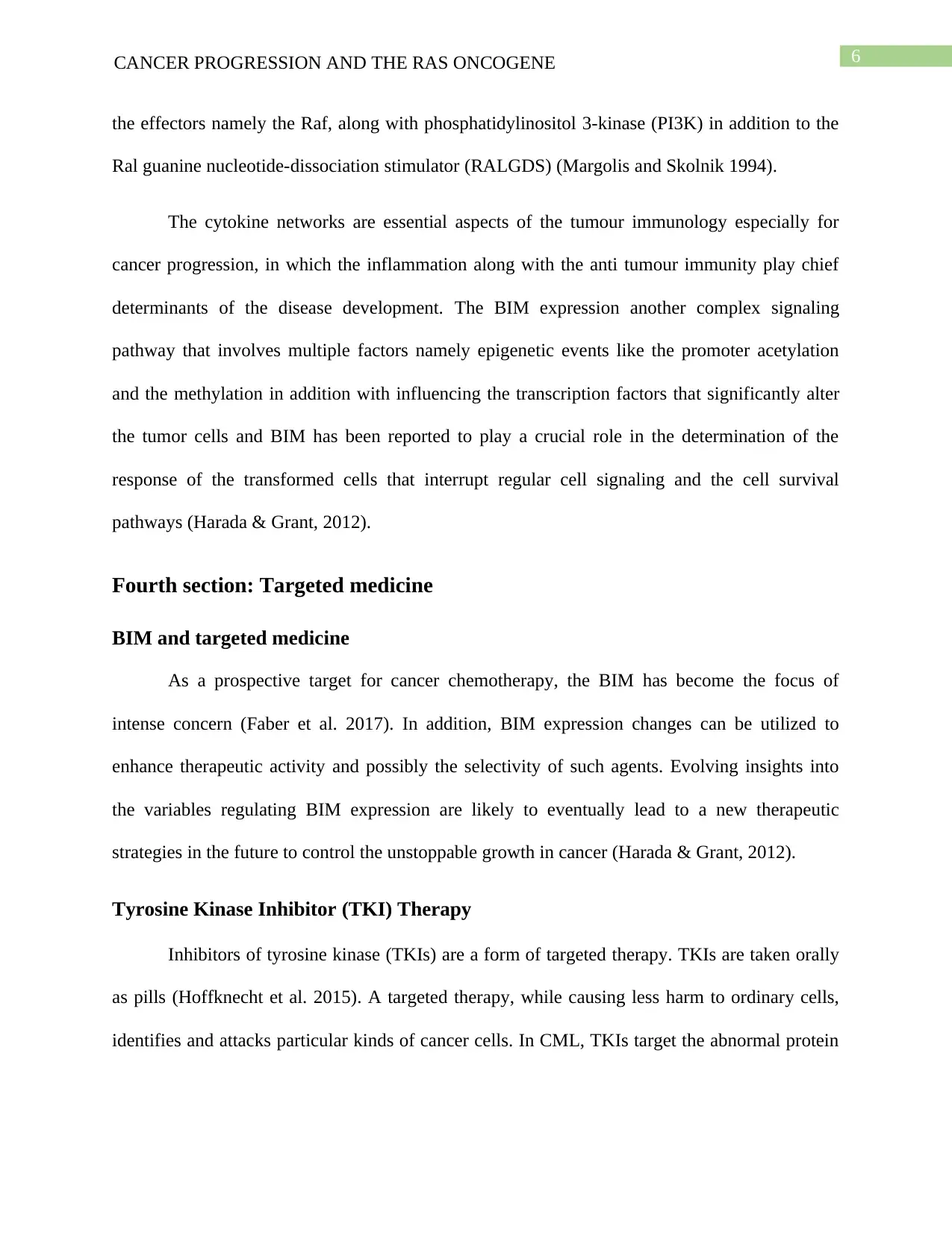
6CANCER PROGRESSION AND THE RAS ONCOGENE
the effectors namely the Raf, along with phosphatidylinositol 3-kinase (PI3K) in addition to the
Ral guanine nucleotide-dissociation stimulator (RALGDS) (Margolis and Skolnik 1994).
The cytokine networks are essential aspects of the tumour immunology especially for
cancer progression, in which the inflammation along with the anti tumour immunity play chief
determinants of the disease development. The BIM expression another complex signaling
pathway that involves multiple factors namely epigenetic events like the promoter acetylation
and the methylation in addition with influencing the transcription factors that significantly alter
the tumor cells and BIM has been reported to play a crucial role in the determination of the
response of the transformed cells that interrupt regular cell signaling and the cell survival
pathways (Harada & Grant, 2012).
Fourth section: Targeted medicine
BIM and targeted medicine
As a prospective target for cancer chemotherapy, the BIM has become the focus of
intense concern (Faber et al. 2017). In addition, BIM expression changes can be utilized to
enhance therapeutic activity and possibly the selectivity of such agents. Evolving insights into
the variables regulating BIM expression are likely to eventually lead to a new therapeutic
strategies in the future to control the unstoppable growth in cancer (Harada & Grant, 2012).
Tyrosine Kinase Inhibitor (TKI) Therapy
Inhibitors of tyrosine kinase (TKIs) are a form of targeted therapy. TKIs are taken orally
as pills (Hoffknecht et al. 2015). A targeted therapy, while causing less harm to ordinary cells,
identifies and attacks particular kinds of cancer cells. In CML, TKIs target the abnormal protein
the effectors namely the Raf, along with phosphatidylinositol 3-kinase (PI3K) in addition to the
Ral guanine nucleotide-dissociation stimulator (RALGDS) (Margolis and Skolnik 1994).
The cytokine networks are essential aspects of the tumour immunology especially for
cancer progression, in which the inflammation along with the anti tumour immunity play chief
determinants of the disease development. The BIM expression another complex signaling
pathway that involves multiple factors namely epigenetic events like the promoter acetylation
and the methylation in addition with influencing the transcription factors that significantly alter
the tumor cells and BIM has been reported to play a crucial role in the determination of the
response of the transformed cells that interrupt regular cell signaling and the cell survival
pathways (Harada & Grant, 2012).
Fourth section: Targeted medicine
BIM and targeted medicine
As a prospective target for cancer chemotherapy, the BIM has become the focus of
intense concern (Faber et al. 2017). In addition, BIM expression changes can be utilized to
enhance therapeutic activity and possibly the selectivity of such agents. Evolving insights into
the variables regulating BIM expression are likely to eventually lead to a new therapeutic
strategies in the future to control the unstoppable growth in cancer (Harada & Grant, 2012).
Tyrosine Kinase Inhibitor (TKI) Therapy
Inhibitors of tyrosine kinase (TKIs) are a form of targeted therapy. TKIs are taken orally
as pills (Hoffknecht et al. 2015). A targeted therapy, while causing less harm to ordinary cells,
identifies and attacks particular kinds of cancer cells. In CML, TKIs target the abnormal protein
Paraphrase This Document
Need a fresh take? Get an instant paraphrase of this document with our AI Paraphraser
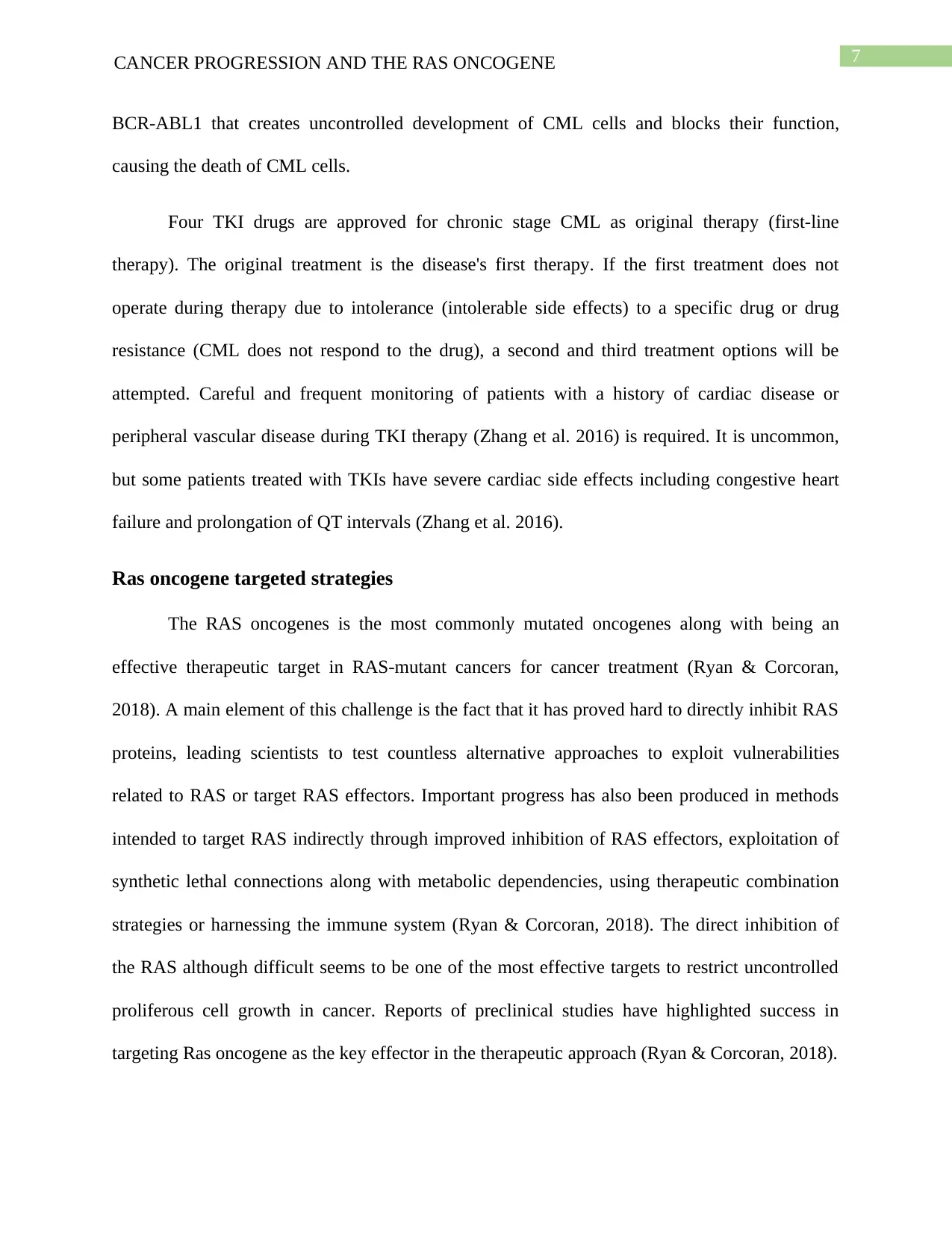
7CANCER PROGRESSION AND THE RAS ONCOGENE
BCR-ABL1 that creates uncontrolled development of CML cells and blocks their function,
causing the death of CML cells.
Four TKI drugs are approved for chronic stage CML as original therapy (first-line
therapy). The original treatment is the disease's first therapy. If the first treatment does not
operate during therapy due to intolerance (intolerable side effects) to a specific drug or drug
resistance (CML does not respond to the drug), a second and third treatment options will be
attempted. Careful and frequent monitoring of patients with a history of cardiac disease or
peripheral vascular disease during TKI therapy (Zhang et al. 2016) is required. It is uncommon,
but some patients treated with TKIs have severe cardiac side effects including congestive heart
failure and prolongation of QT intervals (Zhang et al. 2016).
Ras oncogene targeted strategies
The RAS oncogenes is the most commonly mutated oncogenes along with being an
effective therapeutic target in RAS-mutant cancers for cancer treatment (Ryan & Corcoran,
2018). A main element of this challenge is the fact that it has proved hard to directly inhibit RAS
proteins, leading scientists to test countless alternative approaches to exploit vulnerabilities
related to RAS or target RAS effectors. Important progress has also been produced in methods
intended to target RAS indirectly through improved inhibition of RAS effectors, exploitation of
synthetic lethal connections along with metabolic dependencies, using therapeutic combination
strategies or harnessing the immune system (Ryan & Corcoran, 2018). The direct inhibition of
the RAS although difficult seems to be one of the most effective targets to restrict uncontrolled
proliferous cell growth in cancer. Reports of preclinical studies have highlighted success in
targeting Ras oncogene as the key effector in the therapeutic approach (Ryan & Corcoran, 2018).
BCR-ABL1 that creates uncontrolled development of CML cells and blocks their function,
causing the death of CML cells.
Four TKI drugs are approved for chronic stage CML as original therapy (first-line
therapy). The original treatment is the disease's first therapy. If the first treatment does not
operate during therapy due to intolerance (intolerable side effects) to a specific drug or drug
resistance (CML does not respond to the drug), a second and third treatment options will be
attempted. Careful and frequent monitoring of patients with a history of cardiac disease or
peripheral vascular disease during TKI therapy (Zhang et al. 2016) is required. It is uncommon,
but some patients treated with TKIs have severe cardiac side effects including congestive heart
failure and prolongation of QT intervals (Zhang et al. 2016).
Ras oncogene targeted strategies
The RAS oncogenes is the most commonly mutated oncogenes along with being an
effective therapeutic target in RAS-mutant cancers for cancer treatment (Ryan & Corcoran,
2018). A main element of this challenge is the fact that it has proved hard to directly inhibit RAS
proteins, leading scientists to test countless alternative approaches to exploit vulnerabilities
related to RAS or target RAS effectors. Important progress has also been produced in methods
intended to target RAS indirectly through improved inhibition of RAS effectors, exploitation of
synthetic lethal connections along with metabolic dependencies, using therapeutic combination
strategies or harnessing the immune system (Ryan & Corcoran, 2018). The direct inhibition of
the RAS although difficult seems to be one of the most effective targets to restrict uncontrolled
proliferous cell growth in cancer. Reports of preclinical studies have highlighted success in
targeting Ras oncogene as the key effector in the therapeutic approach (Ryan & Corcoran, 2018).
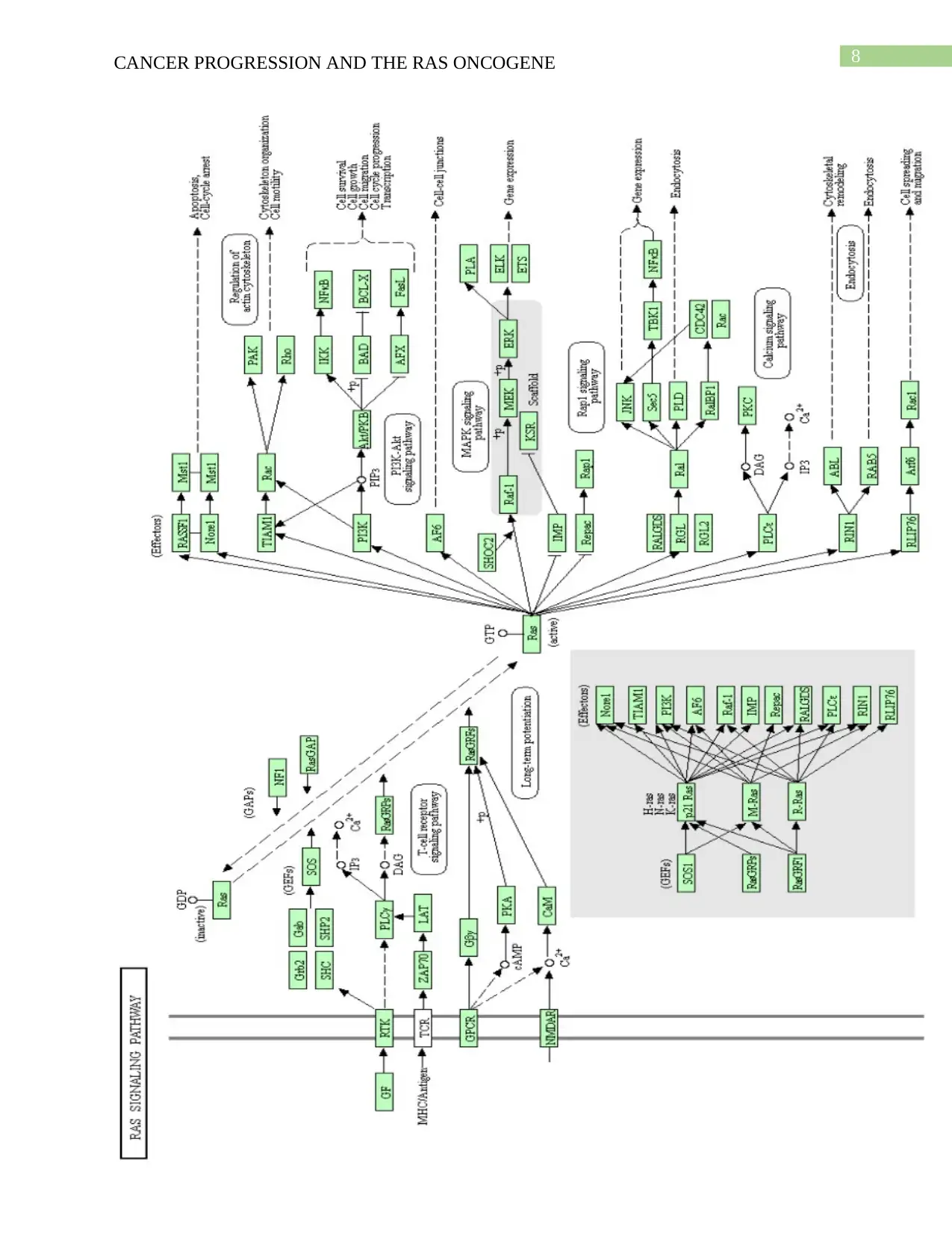
8CANCER PROGRESSION AND THE RAS ONCOGENE
⊘ This is a preview!⊘
Do you want full access?
Subscribe today to unlock all pages.

Trusted by 1+ million students worldwide
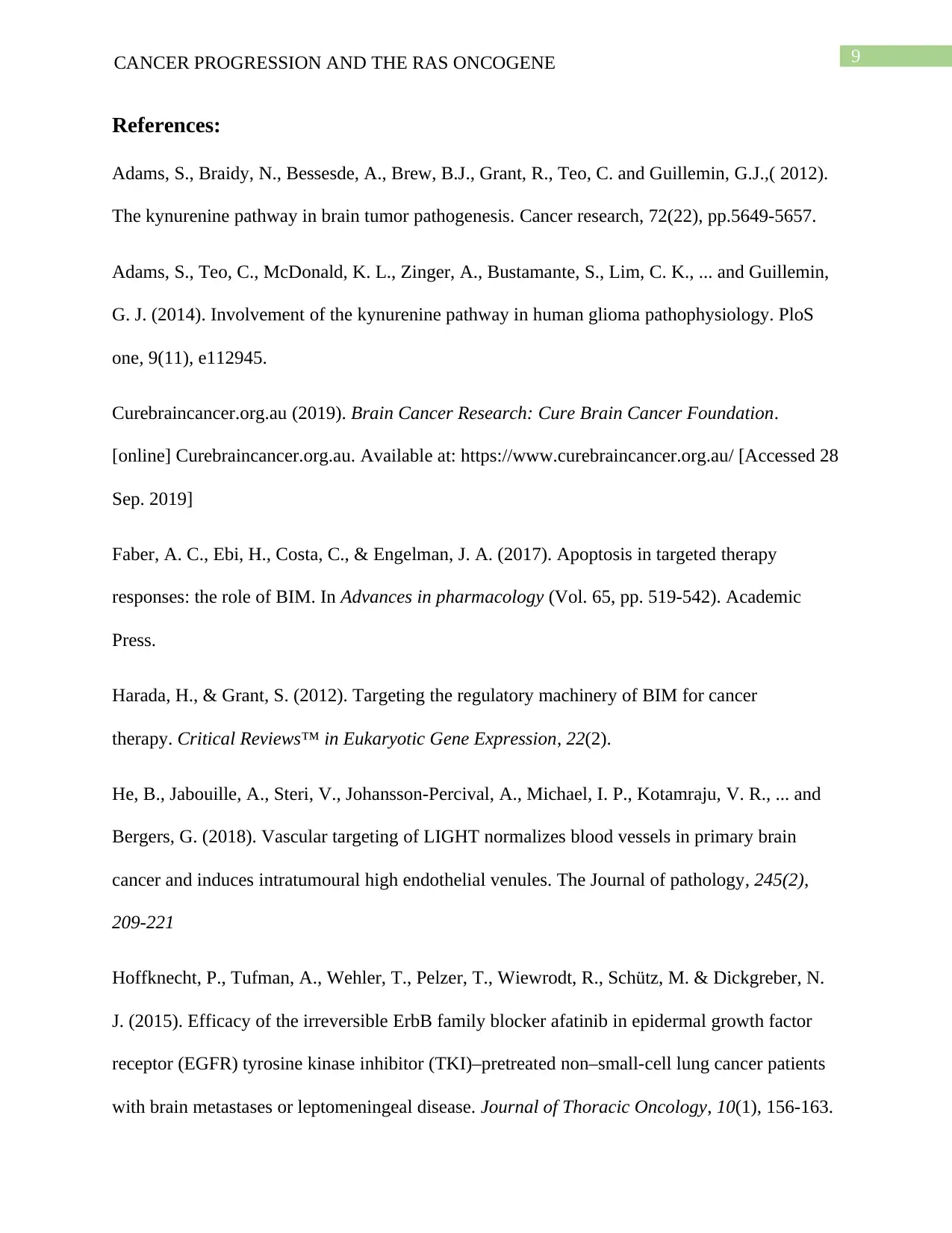
9CANCER PROGRESSION AND THE RAS ONCOGENE
References:
Adams, S., Braidy, N., Bessesde, A., Brew, B.J., Grant, R., Teo, C. and Guillemin, G.J.,( 2012).
The kynurenine pathway in brain tumor pathogenesis. Cancer research, 72(22), pp.5649-5657.
Adams, S., Teo, C., McDonald, K. L., Zinger, A., Bustamante, S., Lim, C. K., ... and Guillemin,
G. J. (2014). Involvement of the kynurenine pathway in human glioma pathophysiology. PloS
one, 9(11), e112945.
Curebraincancer.org.au (2019). Brain Cancer Research: Cure Brain Cancer Foundation.
[online] Curebraincancer.org.au. Available at: https://www.curebraincancer.org.au/ [Accessed 28
Sep. 2019]
Faber, A. C., Ebi, H., Costa, C., & Engelman, J. A. (2017). Apoptosis in targeted therapy
responses: the role of BIM. In Advances in pharmacology (Vol. 65, pp. 519-542). Academic
Press.
Harada, H., & Grant, S. (2012). Targeting the regulatory machinery of BIM for cancer
therapy. Critical Reviews™ in Eukaryotic Gene Expression, 22(2).
He, B., Jabouille, A., Steri, V., Johansson‐Percival, A., Michael, I. P., Kotamraju, V. R., ... and
Bergers, G. (2018). Vascular targeting of LIGHT normalizes blood vessels in primary brain
cancer and induces intratumoural high endothelial venules. The Journal of pathology, 245(2),
209-221
Hoffknecht, P., Tufman, A., Wehler, T., Pelzer, T., Wiewrodt, R., Schütz, M. & Dickgreber, N.
J. (2015). Efficacy of the irreversible ErbB family blocker afatinib in epidermal growth factor
receptor (EGFR) tyrosine kinase inhibitor (TKI)–pretreated non–small-cell lung cancer patients
with brain metastases or leptomeningeal disease. Journal of Thoracic Oncology, 10(1), 156-163.
References:
Adams, S., Braidy, N., Bessesde, A., Brew, B.J., Grant, R., Teo, C. and Guillemin, G.J.,( 2012).
The kynurenine pathway in brain tumor pathogenesis. Cancer research, 72(22), pp.5649-5657.
Adams, S., Teo, C., McDonald, K. L., Zinger, A., Bustamante, S., Lim, C. K., ... and Guillemin,
G. J. (2014). Involvement of the kynurenine pathway in human glioma pathophysiology. PloS
one, 9(11), e112945.
Curebraincancer.org.au (2019). Brain Cancer Research: Cure Brain Cancer Foundation.
[online] Curebraincancer.org.au. Available at: https://www.curebraincancer.org.au/ [Accessed 28
Sep. 2019]
Faber, A. C., Ebi, H., Costa, C., & Engelman, J. A. (2017). Apoptosis in targeted therapy
responses: the role of BIM. In Advances in pharmacology (Vol. 65, pp. 519-542). Academic
Press.
Harada, H., & Grant, S. (2012). Targeting the regulatory machinery of BIM for cancer
therapy. Critical Reviews™ in Eukaryotic Gene Expression, 22(2).
He, B., Jabouille, A., Steri, V., Johansson‐Percival, A., Michael, I. P., Kotamraju, V. R., ... and
Bergers, G. (2018). Vascular targeting of LIGHT normalizes blood vessels in primary brain
cancer and induces intratumoural high endothelial venules. The Journal of pathology, 245(2),
209-221
Hoffknecht, P., Tufman, A., Wehler, T., Pelzer, T., Wiewrodt, R., Schütz, M. & Dickgreber, N.
J. (2015). Efficacy of the irreversible ErbB family blocker afatinib in epidermal growth factor
receptor (EGFR) tyrosine kinase inhibitor (TKI)–pretreated non–small-cell lung cancer patients
with brain metastases or leptomeningeal disease. Journal of Thoracic Oncology, 10(1), 156-163.
Paraphrase This Document
Need a fresh take? Get an instant paraphrase of this document with our AI Paraphraser

10CANCER PROGRESSION AND THE RAS ONCOGENE
Hosein, A. N., Lim, Y. C., Day, B., Stringer, B., Rose, S., Head, R., ... and Martin, J. H. (2015).
The effect of valproic acid in combination with irradiation and temozolomide on primary human
glioblastoma cells. Journal of neuro-oncology, 122(2), 263-271.
KEGG PATHWAY: Tryptophan metabolism - Homo sapiens (human). (2019). Retrieved 29
September 2019, from https://www.genome.jp/kegg-bin/show_pathway?
org_name=hsa&mapno=00380&mapscale=&show_description=hide
Long, G., Dummer, R., Hamid, O., Gajewski, T.F., Caglevic, C., Dalle, S., Arance, A., Carlino,
M.S., Grob, J.J., Kim, T.M. and Demidov, L., (2019). Epacadostat Plus Pembrolizumab versus
Placebo Plus Pembrolizumab in Patients with Unresectable or Metastatic Melanoma: Results of
the Phase 3, Randomised, Double-Blind Echo-301/Keynote-252 Study.
Mangraviti, A., Raghavan, T., Volpin, F., Skuli, N., Gullotti, D., Zhou, J., ... and Lee, D. H.
(2017). HIF-1α-targeting acriflavine provides long term survival and radiological tumor response
in brain cancer therapy. Scientific reports, 7(1), 14978.
Margolis, B., & Skolnik, E. Y. (1994). Activation of Ras by receptor tyrosine kinases. Journal of
the American Society of Nephrology, 5(6), 1288-1299.
Pei, Z., Mendonca, R., Gazzard, L., Pastor, R., Goon, L., Gustafson, A., VanderPorten, E.,
Hatzivassiliou, G., Dement, K., Cass, R. and Yuen, P.W., 2018. Aminoisoxazoles as potent
inhibitors of tryptophan 2, 3-dioxygenase 2 (TDO2). ACS medicinal chemistry letters, 9(5),
pp.417-421.
Ryan, M. B., & Corcoran, R. B. (2018). Therapeutic strategies to target RAS-mutant
cancers. Nature reviews Clinical oncology, 1.
Hosein, A. N., Lim, Y. C., Day, B., Stringer, B., Rose, S., Head, R., ... and Martin, J. H. (2015).
The effect of valproic acid in combination with irradiation and temozolomide on primary human
glioblastoma cells. Journal of neuro-oncology, 122(2), 263-271.
KEGG PATHWAY: Tryptophan metabolism - Homo sapiens (human). (2019). Retrieved 29
September 2019, from https://www.genome.jp/kegg-bin/show_pathway?
org_name=hsa&mapno=00380&mapscale=&show_description=hide
Long, G., Dummer, R., Hamid, O., Gajewski, T.F., Caglevic, C., Dalle, S., Arance, A., Carlino,
M.S., Grob, J.J., Kim, T.M. and Demidov, L., (2019). Epacadostat Plus Pembrolizumab versus
Placebo Plus Pembrolizumab in Patients with Unresectable or Metastatic Melanoma: Results of
the Phase 3, Randomised, Double-Blind Echo-301/Keynote-252 Study.
Mangraviti, A., Raghavan, T., Volpin, F., Skuli, N., Gullotti, D., Zhou, J., ... and Lee, D. H.
(2017). HIF-1α-targeting acriflavine provides long term survival and radiological tumor response
in brain cancer therapy. Scientific reports, 7(1), 14978.
Margolis, B., & Skolnik, E. Y. (1994). Activation of Ras by receptor tyrosine kinases. Journal of
the American Society of Nephrology, 5(6), 1288-1299.
Pei, Z., Mendonca, R., Gazzard, L., Pastor, R., Goon, L., Gustafson, A., VanderPorten, E.,
Hatzivassiliou, G., Dement, K., Cass, R. and Yuen, P.W., 2018. Aminoisoxazoles as potent
inhibitors of tryptophan 2, 3-dioxygenase 2 (TDO2). ACS medicinal chemistry letters, 9(5),
pp.417-421.
Ryan, M. B., & Corcoran, R. B. (2018). Therapeutic strategies to target RAS-mutant
cancers. Nature reviews Clinical oncology, 1.
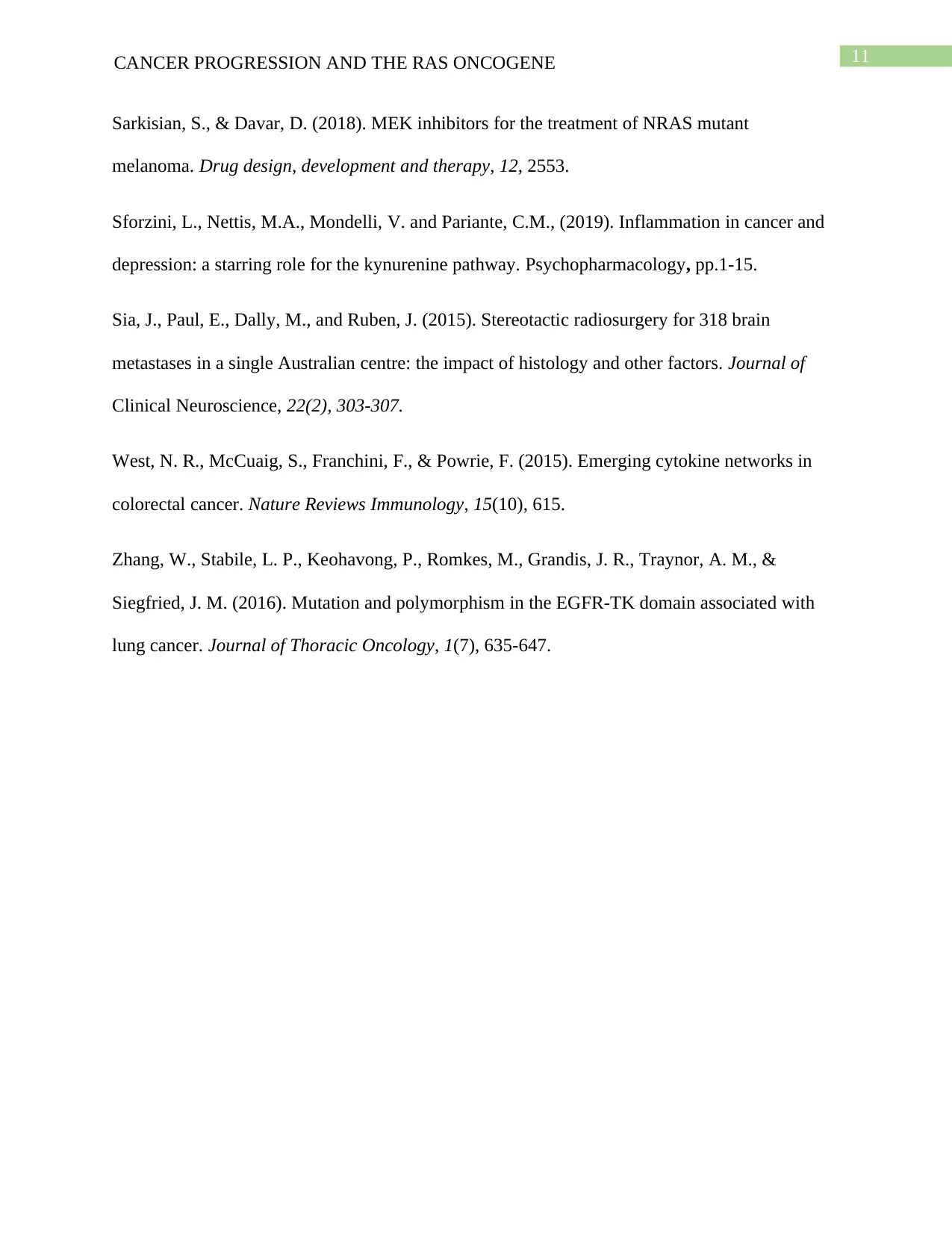
11CANCER PROGRESSION AND THE RAS ONCOGENE
Sarkisian, S., & Davar, D. (2018). MEK inhibitors for the treatment of NRAS mutant
melanoma. Drug design, development and therapy, 12, 2553.
Sforzini, L., Nettis, M.A., Mondelli, V. and Pariante, C.M., (2019). Inflammation in cancer and
depression: a starring role for the kynurenine pathway. Psychopharmacology, pp.1-15.
Sia, J., Paul, E., Dally, M., and Ruben, J. (2015). Stereotactic radiosurgery for 318 brain
metastases in a single Australian centre: the impact of histology and other factors. Journal of
Clinical Neuroscience, 22(2), 303-307.
West, N. R., McCuaig, S., Franchini, F., & Powrie, F. (2015). Emerging cytokine networks in
colorectal cancer. Nature Reviews Immunology, 15(10), 615.
Zhang, W., Stabile, L. P., Keohavong, P., Romkes, M., Grandis, J. R., Traynor, A. M., &
Siegfried, J. M. (2016). Mutation and polymorphism in the EGFR-TK domain associated with
lung cancer. Journal of Thoracic Oncology, 1(7), 635-647.
Sarkisian, S., & Davar, D. (2018). MEK inhibitors for the treatment of NRAS mutant
melanoma. Drug design, development and therapy, 12, 2553.
Sforzini, L., Nettis, M.A., Mondelli, V. and Pariante, C.M., (2019). Inflammation in cancer and
depression: a starring role for the kynurenine pathway. Psychopharmacology, pp.1-15.
Sia, J., Paul, E., Dally, M., and Ruben, J. (2015). Stereotactic radiosurgery for 318 brain
metastases in a single Australian centre: the impact of histology and other factors. Journal of
Clinical Neuroscience, 22(2), 303-307.
West, N. R., McCuaig, S., Franchini, F., & Powrie, F. (2015). Emerging cytokine networks in
colorectal cancer. Nature Reviews Immunology, 15(10), 615.
Zhang, W., Stabile, L. P., Keohavong, P., Romkes, M., Grandis, J. R., Traynor, A. M., &
Siegfried, J. M. (2016). Mutation and polymorphism in the EGFR-TK domain associated with
lung cancer. Journal of Thoracic Oncology, 1(7), 635-647.
⊘ This is a preview!⊘
Do you want full access?
Subscribe today to unlock all pages.

Trusted by 1+ million students worldwide
1 out of 12
Your All-in-One AI-Powered Toolkit for Academic Success.
+13062052269
info@desklib.com
Available 24*7 on WhatsApp / Email
![[object Object]](/_next/static/media/star-bottom.7253800d.svg)
Unlock your academic potential
Copyright © 2020–2025 A2Z Services. All Rights Reserved. Developed and managed by ZUCOL.